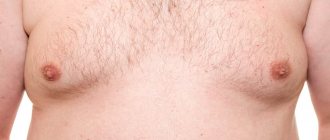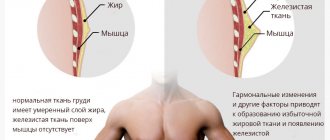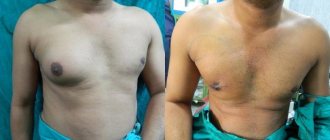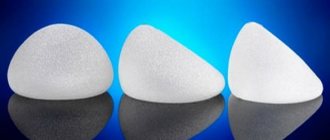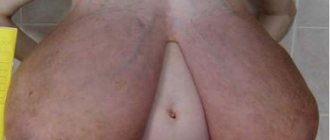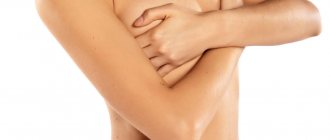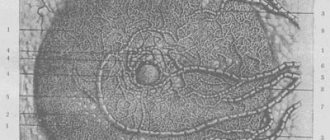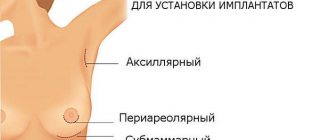Breast enlargement (edema) is a common occurrence. It is not always accompanied by pain, but can confirm the occurrence of various pathologies. You should definitely pay attention to the swelling of the gland. Keep track of the frequency, remember the sensations. This will help the doctor get a complete picture of what is happening. What are the signs, causes of the problem? Are there effective methods to eliminate them?
Breast swelling - signs
An enlarged mammary gland does not necessarily signal illness. In parallel with the swelling, a new symptom develops that causes inconvenience - contact a specialist:
- the pain does not go away even if the woman lies or sits;
- physical activity is impossible;
- fluid from the milk ducts;
- breasts have enlarged.
Headaches, abdominal cramps, loss of activity, and general deterioration in health may also indicate illness.
What foods affect breast growth?
With the help of nutrition, you can adjust the volume of the mammary glands. Some products include phytoestrogens, which are analogues of female sex hormones. They affect the breasts, promoting their enlargement.
Important! An increase in the volume of the mammary glands occurs when eating foods rich in natural hormones.
Mammologists say that to enlarge the bust, it is useful to eat foods containing:
- proteins;
- carbohydrates;
- fats;
- minerals;
- vitamins.
A deficiency of these components negatively affects breast elasticity. The skin may become flabby, and the glands may lose their roundness.
Swelling of the mammary glands - physiological causes
A woman’s body is a complex system with specific features. Breast swelling with a certain frequency is a natural phenomenon and does not pose any danger. There may be several reasons.
Premenstrual period
The growth of the mammary gland is provoked by an egg that has matured. The level of hormones that tell the brain that fertilization is about to occur increases. All systems begin to prepare for breastfeeding, excess fluid accumulates in the tissues. Feelings – chest hurts, tightness.
Nature of the phenomenon:
- The period before ovulation - an increase in the level of the hormone estradiol, estriol, estrone. The substances are catalysts necessary for the growth of the milk ducts.
- After the egg matures, progesterone predominates. It stimulates the growth of cells in the mammary gland.
Such processes should not frighten a woman. But if the pain has intensified and you suffer with every PMS, it’s worth visiting a specialist.
Puberty adolescence
Adolescence in girls provokes swelling of the nipples. The reason is the formation of hormonal levels, the synthesis of substances that affect changes in the body. Clothes that are too tight can cause discomfort. As soon as puberty is completed, all unpleasant sensations will disappear.
Pregnancy
Your menstrual cycle is off, and your breasts are swollen? First signs of pregnancy. Make sure you are pregnant and consult a doctor to rule out any pathologies.
Enlarged glands, heaviness, discomfort are normal phenomena during pregnancy. This is due to progesterone, which prepares the body for feeding the baby. Glandular tissue cells grow. As the fetus grows, the breasts become even more sensitive and increase in volume. A comfortable bra and loose clothing can help reduce discomfort.
Lactation
During the feeding period, the soreness of the mammary glands increases sharply. Milk is produced, the lumens of the ducts expand, and the breasts become fuller. Joins:
- tissues become significantly denser, stiffness;
- increased temperature of the glands;
- localization of pain in certain areas;
- lump-like lumps - palpable after expressing milk;
- redness, cracked nipples.
To eliminate unpleasant symptoms, you should follow the baby’s feeding regimen and regularly express milk. Ignoring the recommendations can lead to a problem – mastitis. A complex disease is accompanied by acute pain, sometimes it is necessary to resort to surgery.
Abortion
Termination of pregnancy is an intervention in the functioning of the body. Hormones have already begun to be synthesized, mammary tissue is preparing for lactation. The consequence of surgery is a serious imbalance in the functioning of the reproductive system. The result will be swollen breasts and periodic pain.
Climax
The period when the restructuring of internal systems associated with age-related changes begins. New processes lead to swelling of the glands. The reason is that glandular tissue is being displaced from the breast, the place of which will be taken by growing fibrous and fatty tissue. Provokes breast growth:
- underwear that is too tight;
- drinking large amounts of liquid;
- excessive salt intake;
- caffeinated drinks.
Increasing pain is not a good symptom; you should consult a doctor.
What determines breast size
The female breast is an organ that produces milk during breastfeeding. Its basis is glandular tissue. It consists of lobes, between which there is a layer of fat.
Some ladies have a lot of this tissue, others have little, so the shape of the most attractive female part of the body can change greatly when gaining or losing weight.
An important role is played by the degree of maturity of the body and the interaction of sex hormones that affect breast growth. Provides volume and circulatory system. Much depends on the parameters of the chest itself and muscle development.
Reasons for breast enlargement not related to pathologies
In addition to natural processes, breast swelling is sometimes associated with:
- Hormonal contraception - a side effect may be breast enlargement, accompanied by pain and discomfort. You need to consult a doctor and choose a different drug.
- Depressive disorder and stress.
- Use of medications. The greatest risk comes from antidepressants, which can unbalance hormonal levels. The body increases the frequency of formation of some substances and sharply reduces the level of others.
- Injuries, any mechanical damage to the breast - the tissues swell, redness and pain appear. You need to see a doctor.
- Excessive consumption of salty foods on the eve of monthly bleeding. The body accumulates fluid, and salt aggravates the process, preventing lymph from being freely excreted from the body.
A narrow, tight bra or tight-fitting clothing can also cause breast swelling.
What foods reduce breast size?
A significant bust volume can cause some discomfort. An increase in the load on the spine is often accompanied by back pain. Women have difficulty choosing clothes and underwear.
Since breasts are composed primarily of fatty tissue, you should eat mostly low-calorie foods. To reduce bust size, it is recommended to include in your diet:
- greenery;
- cabbage;
- radish;
- black radish;
- green peas (fresh);
- cucumbers;
- asparagus;
- lean fish and meat;
- cottage cheese, kefir and whey.
We recommend reading: Potatoes: beneficial properties and contraindications
Important! Green tea helps reduce body fat.
Pathological causes
Severe discomfort, noticeable breast enlargement is a signal from the body about the development of diseases:
- Mastopathy - manifests itself both during menopause and at any age. Signs - after the next menstruation, the breasts become full, sore, and there is a feeling of heaviness. The diagnosis can be cystic, fibrous, diffuse or focal mastopathy.
- Fibroadenoma (during pregnancy). It is associated with the appearance of benign tumors. Causes pain and swelling of the glands. The pathology cannot be treated during pregnancy, since medications cannot be taken.
- Oncology - a disease of a malignant or benign nature causes breast swelling.
It does not matter whether the swelling of the glands is caused by physiology or pathology. You should not ignore the symptoms, but consult a doctor for a correct diagnosis.
What foods do not affect breast growth?
To increase your bust size, you need to eat healthy foods. You should not expect any effect from including in the diet:
- ketchups, sauces and mayonnaise;
- semi-finished products;
- hot spices;
- canned food;
- products made from wheat flour;
- pickled vegetables;
- sweets.
Important! Yeast products can cause dysfunction of the digestive system.
Does not contribute to breast enlargement:
- cabbage;
- milk;
- honey.
These products are good for health. However, they do not affect bust enlargement.
We identify the reason
There were no injuries, but pain and swelling are observed? Take advantage of medical advances - all possible diagnostic methods are at your service. They will allow you to identify pathologies in the early stages:
- Palpation of the chest.
- Ultrasound of the adrenal cortex.
- Mammography.
- Enzyme immunoassays.
- MRI and CT of the adrenal glands and brain.
- Ultrasound of the glands and thyroid gland.
- Blood test for hormone levels.
- Urine testing for nitrogen.
- Examination of the pelvic organs.
The doctor will prescribe diagnostic procedures.
Diagnostics
The nature of the pathology that causes engorgement of the mammary glands is determined by a mammologist. The specialist interviews the patient, finds out when and under what circumstances the symptom arose, and how the disease developed. During the examination, the doctor examines the condition of the mammary glands, palpates regional lymph nodes, and identifies general changes. The further examination program includes:
- Gynecological examination.
It is carried out to establish pregnancy and detect diseases of the female genital organs. Supplemented with a pregnancy test. - Ultrasound of the pelvic organs.
It is carried out to confirm physiological gestation, exclude the ectopic location of the ovum and timely detect pathological pregnancy. - Ultrasound of the mammary glands.
An accessible basic study that allows you to visualize space-occupying formations, inflammatory changes, and disorders of the structure of the mammary glands. Recommended for young women. - Mammography.
It detects the same pathologies as ultrasound; due to age-related changes in the mammary glands, it is more informative in patients of the older age group. According to indications, it is supplemented with ductography, pneumocystography, and digital tomosynthesis. - Breast biopsy.
Indicated in the presence of inflammatory, fibrous, cystic, tumor changes. The tissue or fluid samples are then examined through morphological or microbiological examination. - Lab tests
. The nature and scope of laboratory tests depend on the identified symptoms. Most often, general and biochemical blood tests, a general urine test, and hormone tests are prescribed. A microbiological examination of nipple discharge and determination of the level of tumor markers may be required.
Preventive measures
The physiological processes that occur in the mammary glands are embedded in the genetic code. Therefore, prevention of tissue edema is impossible. Moderate exercise helps normalize carbohydrate metabolism. This is a guarantee that hormonal imbalance will not occur. It is worth limiting your use of:
- soy;
- potatoes;
- flax;
- asparagus;
- wheat;
- dates.
These products pose a threat to normal metabolism.
Treatment
Conservative therapy
Therapeutic tactics are determined by the identified physiological or pathological condition. Pregnant women are registered and pregnancy is monitored. For lactostasis, regular and ultrasonic massage of the mammary gland is performed, decantation is performed, and oxytocin is administered.
Patients with mastodynia and other conditions that occur against the background of cyclical changes are recommended hormonal drugs, sedatives, diuretics and analgesics. In case of hormonal disorders, taking into account the cause of engorgement of the mammary glands, oral contraceptives are canceled or the drug is replaced, and hormone therapy is prescribed. For malignant neoplasms, radiation therapy and chemotherapy may be indicated.
How to stop having complexes
1. Remember that women's breasts are beautiful. And size doesn't matter here.
2. Love and accept yourself. Confidence attracts much more than breasts (if we talk about serious relationships, of course).
3. Stop worrying about what others think of you. You are not a million dollars that everyone wants you. And that's okay.
4. Think about the fact that women with large breasts have as much complex as you about this.
5. Treat yourself with irony.
6. Don’t project your thoughts onto other people: you think that when they first look at you, a person thinks: “How small she is!” And it didn’t even occur to him.
7. Know that many girls with small breasts are proud of it 9 women reveal why they're proud of their small boobs. Why are you worse?
8. If the complex prevents you from living a normal life and nothing helps, contact a psychotherapist and sort out the problem.
9. Find the advantages of small breasts:
- Men like it: many prefer that their breasts simply fit into the palm of their hand. And if a young man breaks up with you because of his breast size, breathe out. You are very lucky, and now you can find someone who will truly love you.
- You don't have to wear a bra.
- Small breasts look neat and aristocratic.
- You won't have back pain due to a heavy bust.
- It makes you look younger.
- You can wear a dress with a deep neckline, and it won't make you look like a prostitute. You can basically wear whatever you want.
- Your breasts, most likely, will not sag with age (or will have a less sad appearance).
- Sleeping on your stomach or sunbathing is comfortable.
Love yourself for who you are. This is the most valuable quality.
10 more proven methods
Let’s not forget to consider other methods of tightening the problem area, which have shown high effectiveness:
- Strength exercises. They will strengthen the pectoral muscles and make the bust firmer and lifted.
- Gymnastics. An excellent opportunity for physical activity and aesthetic pleasure. It prevents bust sagging.
- Special creams. An important component of the bust care complex. Actively fight skin sagging.
- Masks. Masks with natural ingredients are the basis for tightened and beautiful breast skin.
- Wraps. They have the ability to exfoliate, moisturize, renew skin cells and increase its elasticity.
- Massage. Improves blood circulation, removes sagging skin and tones.
- Diet and food. A balanced diet is the basis for youthful and beautiful skin. Controls weight and helps you stay slim.
- Pull-up bra. Makes the silhouette slender and fit, lifts the bust and prevents it from sagging.
- Special stickers. A fashionable part of women's clothing that allows you to wear clothes with an open back and a large neckline.
- Threads and mesothreads. A breast lift using threads makes it firmer and prevents it from sagging.
It is a mistake to think that only by eating certain foods you can increase this part of the body in size. The breast consists of glandular, fatty and connective tissue, which is located on a cushion of pectoral muscles. By pumping them up through intense physical exercise, you can make your bust rise and become taller. Fat is most often not deposited locally in one place, for example, in the bust area. It is also distributed evenly in other roundness of the female body, for example, buttocks and thighs. By adding breast size, you are likely to increase other parts of your body as well.
Acquired chest deformities
Acquired chest deformity in a child develops against the background of diseases of the lungs and ribs (including tumor-like formations). This pathology can lead to other disorders of the body, for example, improper functioning of the respiratory system or psychological problems.
The acquired deformity is characterized by weakened immunity; the child often suffers from acute respiratory viral infections.
Physiological development is inhibited, fatigue appears after weak physical exertion. There are sharp changes in blood pressure.
Acquired curvature of the chest in a child can develop after suffering musculoskeletal diseases:
- Tuberculosis;
- Rickets;
- Scoliosis (Taking into account the fact that the spine and the sternocostal complex are an interconnected system, with severe deformities of the spine, a pronounced deformation of the chest is sometimes observed. More often, the posterior chest wall is deformed in the form of a rib hump, but there are also accompanying deformities of the anterior chest wall);
- Costal osteomyelitis;
- Rib tumors.
Pathology can be provoked by purulent-inflammatory processes in the soft tissues of the chest walls and pleura, injuries and burns of the chest. In some cases, the deformity is a consequence of cardiac surgery after median sternotomy, which can change the growth of the sternum in a child.


